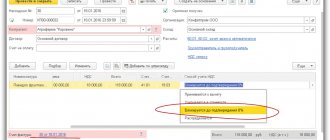Taxpayers submitted reports for 2015 and for the first quarter of 2016. And immediately for these two periods, requests from inspectorates began to pour in demanding clarification of the indicators reflected in the accounting and tax reporting. Inspectors also require the share of VAT deductions to be justified.
Many companies carefully explain everything that interests fiscal officials. However, is it really necessary to write detailed explanations in response to a request? Perhaps, even without them, there is a logical explanation for the notorious “discrepancies” in reporting. Individual indicators in declarations should not coincide at all. This means that there are no discrepancies and there is nothing to explain. Tax officials should be well aware of this.
The company that turned to me for help also received requests from fiscal officials demanding clarification of the indicators reflected in the reporting. The organization had many branches, so the number of requests coming from different inspections grew alarmingly. In this regard, there is a need to systematize all requests and requirements received.
The company's management decided to optimize the work of the accounting department. This was necessary in order to avoid copying unnecessary documents and writing unnecessary explanations. After all, everything took up a lot of working time. The management came to the conclusion that it was necessary to develop a unified approach to the formation of explanations for unlawful requests.
Why compare income based on profit and VAT?
The answer is very simple - the tax office does this, which means we, accountants, need to do this too =)
Tax officials compare VAT and profit returns to find income that the company forgot to charge with VAT.
In the simplest case (if we are analyzing the 1st quarter of the reporting period and we have no accounting difficulties), to reconcile we just need to carefully look at both declarations and check lines 010 + 020 (Sheet 02) in Profit and line 010 (Section 3) in VAT returns.
And this is quite easy to do.
Difficulties begin if we need to compare indicators over 9 months or over a year. Profit is easy to calculate - it is indicated in the declarations on an accrual basis. But with VAT there is already a problem - reporting is quarterly, which means we need to take all declarations from the beginning of the year and summarize their indicators.
Now let’s add some more truths of life:
- refunds to suppliers (increase the VAT base, but no profit)
- customer returns (reduce income in profit, but not in VAT)
- VAT-free income
- different periods of income recognition for export sales
All this leads to the need to understand the discrepancies between VAT and profit
- becomes a very difficult task, requiring a deep dive into accounting, drawing up additional tables and additional checks.
Specialists have a lot of experience in finding VAT and profit differences using Excel tables and “working weekends,” but we are tired of searching everything by hand. We used all our knowledge and experience and developed a special report that allows you to automatically check the convergence of the VAT and Profit base
and take into account common discrepancies. And we are ready to share our findings.
Important: in addition to the adequate reasons for the differences between VAT and Profit, we often find accounting errors that distort the tax base. Our report removes all “resolved” discrepancies and allows you to focus on the actual errors.
We explain to tax authorities the reasons for the discrepancies
171 of the Tax Code of the Russian Federation, the mandatory existence of an agreement in the form of a single document signed by the parties is not required, since by its actions (paying the invoice) the buyer confirms the conclusion of the agreement (resolution of the Ninth Arbitration Court of Appeal dated February 19, 2014 No. 09AP-2239/2014 in case No. A40-131282/13, FAS CO dated 02.08.
2011 in case No. A64-6563/2010). Despite the fact that such errors do not affect the amount of the deduction, tax authorities often deny companies the right to deduction and strongly recommend that they submit a “clarification”. In case of refusal, the tax authorities send a notice to call the company to provide explanations. However, the company may limit itself to providing explanations with correct data (Resolution of the AS SZO dated 01.09.2021 No. F07-7152/2017 in case No. A13-14539/2016). 2) tax benefits are declared (clause 6 of Art.
88 Tax Code of the Russian Federation). One of the most frequent requests from tax authorities during a desk tax audit is the request for documents on preferential transactions reflected in the VAT return in section 7 “Transactions not subject to taxation.” (We would like to remind you that the right to request documents within the framework of the “camera chamber” regarding preferential transactions can be exercised by the tax authorities in a situation where the applied benefit is intended only for a certain category of persons – clause.
14 Resolution of the Plenum of the Supreme Arbitration Court of the Russian Federation dated May 30, 2014 No. 33, resolution of the Supreme Arbitration Court dated February 24, 2015 No. F09-579/15 in case No. A71-6132/2014, dated February 17, 2015 No. F09-10024/14 in case No. A60-21098/2014, dated May 23, 2014 No. F09-5197/12 in case No. A60-32962/2011); The company transferred an advance in an amount greater than provided for by the terms of the contract.
The possibility of accepting the deduction amount in such a situation is confirmed by the Ministry of Finance (Letter dated 02.12.2021 No. 03‑07‑11/8323) and arbitration practice (Resolution of the AS ZSO dated 06.21.2021 No. F04-2547/2016 in case No. A45- 18969/2015).
Concept of a report comparing VAT and Income Tax indicators
- During the analysis, we compare data from regulated reports. Moreover, the report includes the latest adjustment declarations
- Program credentials are used to calculate allowed differences
- Indicators are calculated in full rubles
- “Allowed differences” are divided into two groups:
- Carryover differences (differences in the moment of income recognition)
- Constant differences
is zero.
VAT deductions from advances issued exceed the recovered tax
Let's start with the VAT return. In line 150 of section 3 of these statements, buyers reflect tax deductions on prepayments transferred to suppliers. However, as you remember, having subsequently received goods (work, services) from the counterparty, these deductions must be restored. In the declaration, these amounts are shown on line 110 of section 3.
Carefully! Controllers usually check whether the company has restored the tax previously accepted for deduction from the prepayment.
Tax officials typically monitor whether a company has fully recovered its prepayment deductions. To do this, they compare the data on lines 150 and 110. Having discovered that the indicator on line 110 (that is, the amount of tax recovered) is less, the auditors will probably inform the company about this. And they will demand to either correct the reporting or explain the reason for the discrepancy with the data in line 150. How to respond to such a request?
Can tax authorities require a company to explain discrepancies between its income tax return and financial statements?
Yes, controllers may request such clarifications. The Tax Code of the Russian Federation allows this.
How long does it take to provide tax authorities with explanations regarding discrepancies in reporting?
The explanations requested by them must be provided to the controllers within five working days. This is stated in paragraph 3 of Article 88 of the Tax Code of the Russian Federation.
Do auditors have the right to request any documents from the company if they find discrepancies in reporting?
No. Tax officials only have the right to require the company to provide explanations or make corrections to the declaration.
Tax officials want us to decipher the structure of non-operating expenses. Is this legal?
Yes, if they really identified errors or contradictions (letter of the Ministry of Finance of Russia dated July 25, 2012 No. 03-02-08/65).
First of all, we advise you to check whether you have recovered the tax on all advances that the supplier covered with shipments this quarter. If not and you forgot about some amount, then draw up an updated declaration now and hand it over to the inspectors. Before doing this, pay additional taxes and penalties.
But let’s say that you indicated everything correctly in the reporting. And the data in lines 150 and 110 do not necessarily have to be equal to each other. Let's say the company transferred an advance to the seller in the third quarter. And he will deliver the goods only in the next tax period. In this case, the amount of VAT deduction from this prepayment will lead to the difference between the indicators. This needs to be explained to the tax authorities. An example of an explanation letter is provided below.
We add that you can attach supporting documents to the letter. For example, a purchase book or a sales book for the corresponding period. It is better to convey the explanations directly to the inspectorate in person. After all, if you send them by mail, they may reach the tax authorities with a delay, or even get lost altogether.
And by the way. You don’t have to deduct tax on prepayments at all. Because this is the buyer's right, not an obligation. Officials agree with this. An example of this is the letter of the Ministry of Finance of Russia dated April 9, 2009 No. 03-07-11/103. Then these amounts will not have to be restored in the quarter when the company receives goods from the supplier. And this will not cause discrepancies in reporting.
Let's start with the VAT return. In line 150 of section 3 of these statements, buyers reflect tax deductions on prepayments transferred to suppliers. However, as you remember, having subsequently received goods (work, services) from the counterparty, these deductions must be restored. In the declaration, these amounts are shown on line 110 of section 3.
Taxpayer income is divided into two categories: capital income and labor income. In Finland, the total tax burden is 43.8% of GDP in the form of direct taxes, in particular personal income, which is 16.7% of the total tax. The share of indirect taxes is 14.5%, and social contributions, mainly paid by employers, are 12.7%.
Carefully! Controllers usually check whether the company has restored the tax previously accepted for deduction from the prepayment.
Tax officials typically monitor whether a company has fully recovered its prepayment deductions. To do this, they compare the string data and . Having discovered that the indicator of line 110 (that is, the amount of the restored tax) is less, the auditors will probably inform the company about this. And they will demand to either correct the reporting or explain the reason for the discrepancy with the data in line 150. How to respond to such a request?
Examples of using the report
Video review of the development
Let's consider the work of the report using the example of one year of the organization's work
1st quarter
In the 1st quarter we see the following situation:
- adjustment declarations are used for analysis (k/1)
- in this quarter, the VAT rate of 0% was confirmed for the amount of 10,878,485 rubles (for income tax purposes, these sales were taken into account in previous quarters)
- For sales in the amount of 3,730,529 rubles, the 0% rate has not yet been confirmed
Result: there are no erroneous differences, all differences are “allowed”
2nd quarter
This quarter we see a similar situation with differences, but the indicators are already considered both quarterly and cumulatively - to facilitate reconciliation. Please note that indicators that are obtained by calculation are highlighted in gray (you will not find these figures in the declarations).
3rd quarter
In the 3rd quarter we see a difference of 33,700 rubles. If you analyze all the data, you can find the reason for the difference - the presence of non-operating income not subject to VAT.
Setting up other income not subject to VAT
There is a special setting in the VAT and Profit reconciliation report that allows you to specify a list of non-operating expenses that should not be subject to VAT and that must be included in the “allowed” differences.
If an item of other income is added to this list, then the detail “Not subject to VAT” is filled in (it can also be set in the directory itself).
This allows you to build SALT for the 91st account, grouped by VAT taxability. By default, this list is filled with unambiguously “allowed” differences. The user can independently supplement the list. In this case, we will add the article “Insurance compensation (MTPL)” to the exceptions.
As a result, we will receive a report in which there are no unresolved differences
4th quarter
In the 4th quarter we see that a whole range of “allowed” differences have been taken into account:
- unconfirmed export 0%
- returns of goods to the supplier
- returns of goods from customers
- non-operating income not subject to VAT
And still we get an unresolved difference. In this case, it means the presence of an accounting error in the VAT or Profit return. Additional data analysis (outside the scope of this report) is required to identify the error. But our primary recommendation is to update the closing of months, the formation of a sales book and refill tax returns.
The procedure for writing an explanatory note
To date, there is no legislative regulation for the preparation of an “explanatory” form. Drawing up an explanation to the tax office about discrepancies in the declaration is carried out in any form. The main condition is to provide a clear answer to the question asked, and the history of the origin of inaccuracies in the declaration. In practice, two clarification options are used:
- The identified error is reflected in the explanatory note, but always with reference to the correct data;
- The presence of an error is refuted, explanations and relevant data are provided that confirm the inclusion of this information in the declaration. An example of this situation could be discrepancies in reconciliation between the enterprise and its counterparties.
Frequently asked question: VAT discrepancies associated with the discovery of an error in VAT calculation between the company data and the supplier. The occurrence of these discrepancies may be due to a number of reasons:
- The supplier's declaration does not contain information about the shipment of goods;
- The supplier of the goods is an intermediary.
The current legislation stipulates that when issuing an invoice on behalf of its customer, the intermediary is exempt from charging VAT; this function must be performed by the direct supplier. Thus, the presence of shortcomings may be due to the lack of appropriate actions on the part of the principal, failure to provide them with accounting logs or incorrect provision of them. In this case, it is necessary to additionally provide supporting documents: a letter from the counterparty, a commission agreement.
The cost of development is 6,000 rubles.
One year of free support (if the configuration is updated or the form changes, we will fix everything)
A year of additional support costs RUB 3,000.
Other information: The report was tested on versions: 1C: Enterprise Accounting 3.0.53 and higher
If necessary, we can provide paid consultations on identifying the differences between income tax and VAT.
If it is necessary to take into account individual nuances and modifications to work in changed configurations, the work is paid by the hour.
Information load of “tax requirement”
Get 267 video lessons on 1C for free:
- Free video tutorial on 1C Accounting 8.3 and 8.2;
- Tutorial on the new version of 1C ZUP 3.0;
- Good course on 1C Trade Management 11.
- Code “1” indicates that a declaration for the previous period was not provided. The information contained in the declaration is not included in the counterparty’s reporting;
- Code “2 – discrepancies were identified in the accounting logs;
- Code “3 – discrepancies were identified regarding the actions of intermediaries;
- Code “4 – other questions.
After studying the presented requirement, you can begin writing an explanation.
Updates
We provide new development versions free of charge within a year after purchase.
One year of additional support - 3,000 rubles. Attention, we do not guarantee the functionality of the development for which the additional support period has not been paid for.
The current version of the development can be obtained by writing to us by email. Managers will check whether you have access to support, send a new version or send an invoice.
Version 1.2
- interface fixes
Version 1.3
- the report has been prepared for use in cloud versions
- Fixed errors in report generation for users with limited rights
Version 1.4
- New indicators have been added to the allowed differences: Unconfirmed sales 0% (in case of additional VAT charges)
- Sales according to 90.01.1 without VAT
- Implementation according to 90.02.2 UTII and Patent
- the year-end closing mechanism was taken into account when analyzing accounts 90 and 91
- fixed determination of differences in returns to suppliers and from customers
Version 1.5
- Adjustments to sales taken into account (downward)
- Adjustments to sales downwards from sales from previous years have been taken into account
Version 1.6
- Added control for discrepancies in revenue and other income according to accounting data (90.01 and 91.01) and according to the profit declaration data
Version 1.7
- The 2021 analysis shows a VAT rate of 20%
- Corrected the indicator “Confirmed export sales” (Section 4 line 020) in the 2021 reports
- The difference of 1 ruble between SALT and the Profit Declaration is not controlled
Version 1.8
- We added revenue data for other operations (Appendix No. 3 to Sheet 02) to the analysis of the convergence of accounting and reporting data - this is usually the sale of fixed assets or intangible assets
- Added the ability to open regulated reports via hyperlink (in one click you can open everything you need for reconciliation)
- Added a description of the “Difference” column - the main reasons and necessary actions
Version 1.9
- This release adds checking for discrepancies in gratuitous transfer transactions
Version 1.10
- Added a new indicator “Shipment without transfer of ownership”
- Identified errors have been corrected
Version 1.11
- Added a new indicator “Sales of shipped goods” (actual transfer of ownership)
- We have finalized indicator 040 of section 4 of the VAT return. Now all the lines of this column are summed up
Version 1.12
We decided to make development even more convenient and transferred the functionality to the Extension. This will allow:
- more convenient to open development
- It’s more convenient to set up other income and expense items
- improve checking the compatibility of development with future versions of 1C:Accounting
But we haven’t forgotten about the development of functionality:
- We show differences only if there is something to show
- simplified setting up the item of other income from expenses (the “Not subject to VAT” flag)
- added a certificate for the indicator “Sales at a rate of 0%” (to open you need to click the “?” sign)
Version 1.13
- The extension is adapted to version 1C: Accounting 3.0.75
Version 1.14
The extension has been adapted to the new form of the regulated Profit report from the 4th quarter of 2021 (1C: Accounting 3.0.75)
Version 1.15
- added analysis of returns to the supplier (if it is made on the basis of an adjustment invoice)
- identified errors have been fixed
Version 1.16
- the long-awaited decoding of discrepancy indicators
- other income “Return of goods sold in the previous tax period” has been added to the default exceptions
Version 1.17
- Fixed minor inconvenience of adding other income
- Improved determination of the required declaration in the presence of separate divisions
How to fill out sections of the VAT explanation form, according to the above coding
Using code “1”, fill out section No. 8 “Information from the purchase book” and information containing an explanation of discrepancies/errors/contradictions/inconsistencies.
Using code “2”, you should fill out section No. 9, which consists of two plates - information from primary accounting documents and data that explains the identified discrepancies.
For code “3”, explanations are entered in section No. 10, consisting of two plates - information that corresponds to the primary accounting documentation, and explanatory information.
Using code “4”, the taxpayer, tax agent or other person (list in the Tax Code - Article No. 173) enters explanations into section No. 12, which consists of two tables - information that corresponds to the primary accounting documentation, and data that will explain the identified contradictions.
It may happen that several errors are identified and it is necessary to fill out several sections of the VAT explanation at once, then each of the sheets must be certified by the signature of the person filling out the forms, or the individual entrepreneur. In addition, the entrepreneur should also indicate the details of the registration certificate (this does not apply to legal entities).
After explaining all errors, the taxpayer sends the completed document to the local tax office.
What are sales revenues?
This is, first of all, profit that was received as a result of the sale of goods or the provision of services in-house or through intermediary services. Such income includes:
- Revenue received from the sale of goods or services.
- Proceeds received from the sale of property and securities.
In practice, two types of income definitions are used.
The first type is for shipment, the second is for payment. The sale of goods when the goods have been shipped to the client and documents for payment have been presented is considered the shipping method. Upon payment it is considered when the shipped goods were immediately paid for by the buyer.
Question test on the topics of the issue
- 1 Tax officials sent a message to the company that the amount of expenses in the income tax return differs from similar figures in the financial statements. In this situation, do controllers have the right to demand that contracts with counterparties and other documents be presented to them?
- A. Yes, I have the right.
B. No, you have no right.
The correct answer is B. If tax authorities have identified errors or contradictions in a company's reporting, they can only ask it for clarification. Or demand that the necessary corrections be made to the declaration. This is stated in paragraph 3 of Article 88 of the Tax Code of the Russian Federation.
The next question in the article “Frequent mistakes, eradicating which you will make your balance sheet perfect.”
- How to calculate store profitability
Reviews about our work
| The processing is very cool! It helps a lot in my work and saves a lot of time. I use it quarterly for reporting. If there is a discrepancy between the tax bases for income tax and VAT, you can check it before submitting your reports and, if necessary, correct it. Previously, in order to check the compliance of the bases, it was necessary to raise the income tax for VAT for all periods of the current year, write down the numbers somewhere, add them up, and then only check them with the income tax income tax. And if you wrote it down incorrectly or someone was distracted at that moment, then the result will be incorrect. Now everything is done very quickly, you can say with one click of a button. The report shows exactly where the discrepancies are and it is very easy to find and check them. Accordingly, the response to the request of the Federal Tax Service is made quickly. Thanks to the developer! I recommend it to all accountants who work for OSNO! |
Before the appearance of this report, a large amount of time was spent checking the correctness of discrepancies between VAT and Income Tax revenues; now this task has been simplified to a minimum, which frees up time for other work, which is especially valuable during the reporting period.








